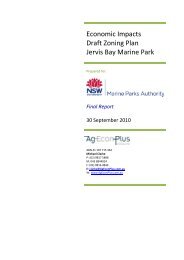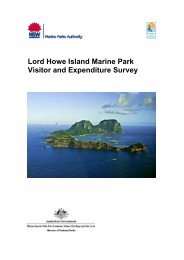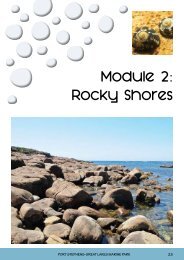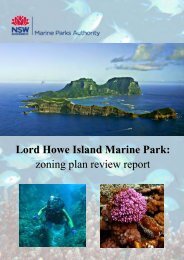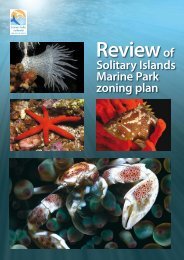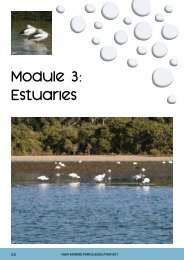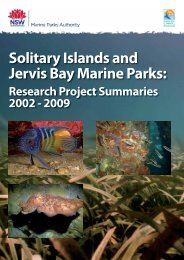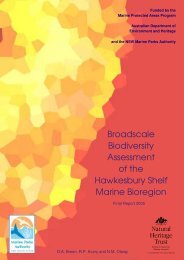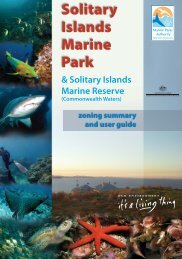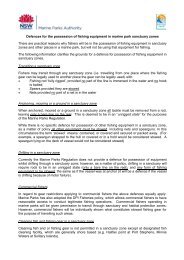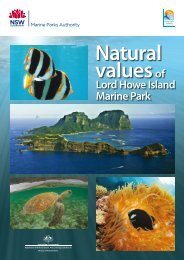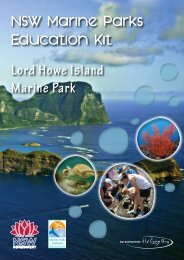Natural values of the Solitary Islands Marine Park - Marine Parks ...
Natural values of the Solitary Islands Marine Park - Marine Parks ...
Natural values of the Solitary Islands Marine Park - Marine Parks ...
- No tags were found...
You also want an ePaper? Increase the reach of your titles
YUMPU automatically turns print PDFs into web optimized ePapers that Google loves.
34 <strong>Natural</strong> <strong>values</strong> <strong>of</strong> <strong>the</strong> <strong>Solitary</strong> <strong>Islands</strong> <strong>Marine</strong> <strong>Park</strong>sperm whale (Physeter macrocephalus), short-finnedpilot whale (Globicephala macrorhynchus), straptoothbeaked whale (Mesoplodon layardii), Fraser’s dolphin(Lagenodelphis hosei), spotted dolphin (Stenellaattenuata), striped dolphin (Stenella coeruleoalba),dugong (Dugong dugon), leopard seal (Hydrurgaleptonyx), and Australian fur seal (Arctocephaluspusillus). The distribution <strong>of</strong> <strong>the</strong>se mammals extendswell beyond <strong>the</strong> marine park region. In <strong>the</strong> marinepark, several are at <strong>the</strong> extreme limit <strong>of</strong> <strong>the</strong>ir rangeand <strong>the</strong>refore uncommon.Figure 47.Green turtle.7.3 <strong>Marine</strong> reptiles<strong>Marine</strong> reptiles are common in <strong>the</strong> marine park. Four <strong>of</strong> <strong>the</strong> world’s seven species <strong>of</strong>marine turtle have been recorded (Ganassin and Gibbs, 2005a, b). Most <strong>of</strong>ten seen are<strong>the</strong>:• green turtle (Chelonia mydas) (Figure 47),• loggerhead turtle (Caretta caretta),• hawksbill turtle (Eretmochelys imbricata).Lea<strong>the</strong>rback turtles have also been observed, although rarely (NPWS unpubl. data,Zann 2000a).Sea turtle nesting, mainly <strong>of</strong> green turtles but also <strong>of</strong> loggerhead turtles, has beenrecorded on several beaches, including those at Red Rock, Diggers Camp, HearnesLake and Sandon. Some eggs have hatched successfully.While 11 species <strong>of</strong> sea snakes occur in NSW waters, sightings are uncommon. Only afew species have been recorded in <strong>the</strong> region (Ganassin and Gibbs 2005a), including<strong>the</strong> elegant sea snake Hydrophis elegans and yellow-bellied sea snake Pelamis platurus.See NSW Department <strong>of</strong> Primary Industries 2004 for more details on <strong>the</strong> distributionand biology <strong>of</strong> several <strong>of</strong> <strong>the</strong>se species.7.4 BirdsBirds that depend on marine and estuarine habitats include true seabirds, shorebirds,waders, waterfowl and birds <strong>of</strong> prey (Higgins and Davies 1996, Higgins 1999). Thereare over 120 species <strong>of</strong> coastal and marine birds in <strong>the</strong> region. Of <strong>the</strong>se, around 100species commonly occur on <strong>the</strong> coasts and inshore waters, many <strong>of</strong> <strong>the</strong>m on aseasonal basis (Ganassin and Gibbs 2005a and b) (Figure 48).Figure 48.Winter visitors – gannets.Some vegetated <strong>of</strong>fshore islands are important potential breeding sites for seabirds.The species recorded as breeding on <strong>the</strong>se islands are <strong>the</strong> wedge-tailed shearwater,crested tern, silver gull, white-faced storm petrel, sooty oystercatcher and possibly<strong>the</strong> fluttering shearwater and buller’s shearwater.Ospreys also nest on one <strong>of</strong> <strong>the</strong> islands (Figure 49),and this is <strong>the</strong> only record <strong>of</strong> ground nesting forosprey in NSW.Species found in estuarine habitat include variouswaders, such as whimbrel and eastern curlew.Summer migrant species include <strong>the</strong> mongolianplover, grey tailed tattler, bar-tailed godwit, sharptailedsandpiper and red-necked stint



